
The Pieridae are a large family of butterflies with about 76 genera containing about 1,100 species, mostly from tropical Africa and tropical Asia with some varieties in the more northern regions of North America and Eurasia. Most pierid butterflies are white, yellow, or orange in coloration, often with black spots. The pigments that give the distinct coloring to these butterflies are derived from waste products in the body and are a characteristic of this family. The family was created by William John Swainson in 1820.
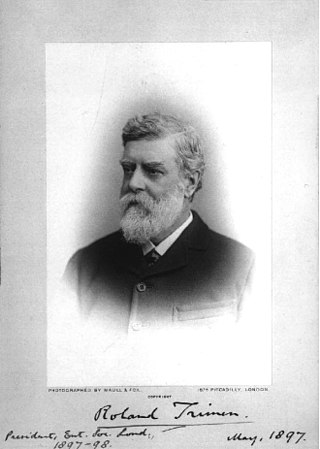
Roland Trimen FRS was a British-South African naturalist, best known for South African Butterflies (1887–89), a collaborative work with Colonel James Henry Bowker. He was among the first entomologists to investigate mimicry and polymorphism in butterflies and their restriction to females. He also collaborated with Charles Darwin to study the pollination of Disa orchids.

The Somabrachyidae are a family of moths in the order Lepidoptera. Other than Somabrachys aegrota, which also occurs in Spain and on Sicily, the family is Afrotropical.

The variegated butterfly bat is a species of vesper bat. It is sometimes also called the leaf-winged bat, or simply the butterfly bat. It is not currently endangered, but may be threatened by habitat loss in some parts of its range.

Junonia oenone, the blue pansy or dark blue pansy, is a Nymphalid butterfly native to Africa. "Blue pansy" is also used in India to describe Junonia orithya.

Zizeeria knysna, the dark grass blue or African grass blue, is a species of blue butterfly (Lycaenidae) found in Africa, on Cyprus and the Iberian Peninsula.
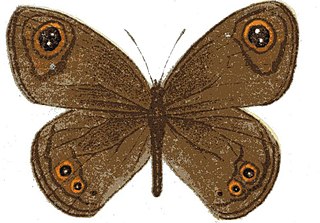
Neita is a genus of butterflies from the subfamily Satyrinae in the family Nymphalidae.
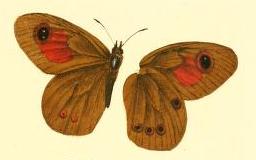
Neita neita, the Neita brown, is a butterfly of the family Nymphalidae. It is found in South Africa in several isolated populations in grassland and grassy savanna covered hillsides from Eastern Cape into KwaZulu-Natal, Swaziland, Mpumalanga, Limpopo and North West.

Neita durbani, or D'Urban's brown, is a butterfly of the family Nymphalidae. It is found in South Africa in scattered populations in grasslands in the Eastern Cape and grassy mountain slopes at medium altitude from the Camdeboo Mountains along the escarpment to Bedford and Stutterheim, south to Grahamstown, and north to the Dordrecht Kloof and Jamestown.
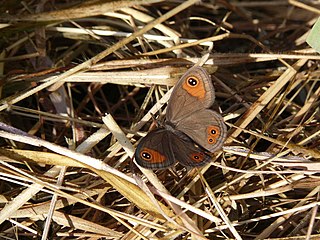
Neita extensa, is a butterfly of the family Nymphalidae. It is found in South Africa from Mpumalanga to Limpopo and further north to Zimbabwe.

Coeliades forestan, the striped policeman, is a butterfly of the family Hesperiidae. It is found from Transkei to Zimbabwe and to Botswana. It is also present on Madagascar and Mauritius.
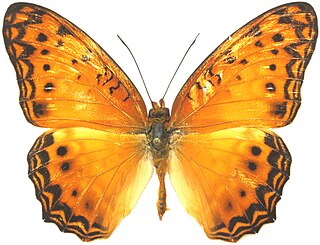
Phalanta eurytis, the forest leopard, forest leopard fritillary, or African leopard fritillary, is a butterfly of the family Nymphalidae. It is found in tropical Africa, Ethiopia, and Sudan.

Pseudonacaduba sichela, the African line blue, dusky line blue or dusky blue, is a butterfly of the family Lycaenidae. It is found in Africa, south of the Sahara.

Appias epaphia, the diverse white or African albatross, is a butterfly of the family Pieridae. It is found in Africa, south of the Sahara. The habitat consists of forests and heavy woodland.

Catopsilia florella, the African migrant, African emigrant, or common vagrant, is a butterfly of the family Pieridae. It is found in Africa, Arabia and the Canary Islands. Like Catopsilia pomona, this species also has a habit of migration.
Neita orbipalus is a butterfly in the family Nymphalidae. It is found in Tanzania.
Neita victoriae is a butterfly in the family Nymphalidae. It is found in Tanzania and south-western Kenya. The habitat consists of Brachystegia woodland.

Daryll Neita is a British sprinter. In 2022, she won her first individual international medals, with bronze in the 100 metres at both the European Championships and Commonwealth Games. Neita claimed bronze for the 60 metres at the 2023 European Indoor Championships. She has won several medals as part of Great Britain 4 × 100 m relay teams, including Olympic bronze medals in 2016 and 2021, World Championships silver medals in 2017 and 2019, and European gold in 2018.














